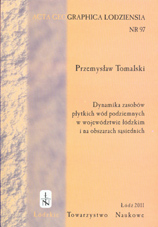Dynamika zasobów płytkich wód podziemnych w województwie łódzkim i na obszarach sąsiednich
The Dynamics of Shallow Groundwater resources in the Łódź Region and Neighbouring Areas
Author(s): Przemysław TomalskiSubject(s): Cultural Essay, Political Essay, Societal Essay
Published by: Łódzkie Towarzystwo Naukowe
Keywords: hydrogeology; shallow groundwater; dynamic; typology
Summary/Abstract: There are shown the results of the research about variability of groundwater resources gathered in shallow aquifers located in the province of Łódź and nearby areas. In the hydrological meaning, that territory includes the second row catchments: Bzura, Skrwa (Lewa), Jeziorka, Pilica, Warta up to Poznań and some areas of the surrounding catchments. The research included 41 aquifers with continuous data from at least 30 years, gathered in years 1951–2000. Those aquifers represented a whole spectrum of geographical and hydrogeological conditions of the research area. Homogeneity of the time series was checked by using two statistical tests: non parametric (series test) and parametric (F–Snedecor test) ones. Afterwards, the dynamics of groundwater resources was described. That variability consists of short-time fluctuations (characterized by the weekly changes of groundwater level), seasonality and multiannual changeability. The analysis of yearly extreme location of groundwater level was conducted too. The aquifers of that region characterize with poor seasonality of groundwater level fluctuations. It seems that higher yearly variability is connected to small wealthy of the aquifers. In the richer aquifers rhythms of changeability of groundwater level were longer. In multiannual period there was a relative stability of aquifers fullness observed in central Poland. Over 70 % of them did not show statistically significant tendencies for groundwater level decrease or increase. There was not any spatial order of examined characteristics. Only in large part of Pilica river catchment there were some individual features of the observed rhythms concerning especially higher frequency variability. Estimators of groundwater dynamics were confronted with basic geographical and hydrogeological characteristics of aquifers (average depth to groundwater level, isolation from the surface, type of aquifer and vulnerability to pollution). The presence of any relations between the estimators and these characteristics was checked by the χ2 test. Co-variableness of examined estimators and average depth to groundwater level was detected most frequently. That characteristic strongly differentiated the aquifers at the seasonal variability (all the estimators depend on it). Multiannual fluctuations of groundwater level were definitely less differentiated. At the end the attempt of typology of groundwater resources dynamic was done. The principal component analysis was used to that procedure (based on the covariance matrix from specially selected data: all of them had to have similar variances). Next the first two principal components were grouped by Ward’s hierarchical clustering method. The optimal number of classes was established by using the VRC criterion. Finally the eight classes of groundwater dynamic were created. There was not any spatial order in the aquifers with similar types of groundwater dynamics.
Journal: Acta Geographica Lodziensia
- Issue Year: 2011
- Issue No: 097
- Page Range: 1-112
- Page Count: 112
- Language: Polish

